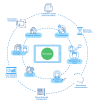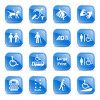The cloud space is forever growing with new software that has the sole purpose of making your life easier. So how do you know which add-ons are right for you? It’s all about personalising your software eco system to suit the needs of your business. These days, if you’re keeping a spreadsheet to track something, you can be sure that there is an add-on out there waiting for you. Add-ons will almost always do more than what you were initially hoping which ends up automating processes you hadn’t even thought about yet!
Here are our top three cloud software products that will automate processes within any small business.
Xero
Beautiful accounting software that is the base for all your financial information. Highly rated for user experience and software integrations means that you have easy access to a huge marketplace of Add-ons that fully integrate for rich real time data.
Receipt Bank
The ultimate bill processing software that accurately extracts data from scanned receipts & invoices, publishes straight to Xero and attaches the scan for reference. By eliminating this daily or weekly data entry, you are free to focus on the more interesting areas of your business with no more filing
Deputy
Perfect for employee scheduling, time and attendance. Employees log in and out of each shift through a tablet kiosk and at the end of the pay period, Deputy exports the timesheet data into Xero enabling payroll to be processed
If you have these basics and are ready to look into something more tailored to your industry, take a look at what these add-ons have to offer.
Kounta
If you are in need of a point of sale system (POS) then look no further. Kounta is an extensive restaurant and cafe software system that automates more than just your daily sales figures. You can create custom table layouts to track service times, develop ‘recipes’ to accurately account for stock on each menu item, integrate loyalty program add-ons and more.
Collect
Looking for a CRM that also has a loyalty program? Collect combines the benefits of a loyalty program with the ability to generate targeted email offers and feedback all from one app. Integrating with Kounta means that your customers earn points for every sale, and their rewards are automatically applied at the checkout. With optional point balance emails, you can ensure that you are at the forefront of your customer’s minds.
Vend
Vend looks after all your retail outlet’s transactions and integrates with Xero giving you real-time financial data. While offering inventory tracking, the system also contains purchase tracking for customers meaning you are able to segment your customers and market directly to particular groups, and make decisions based on purchase history.
Asana
To help keep on track with your projects and tasks, Asana gives you a platform where you can create projects, tasks and assign them to your team members. You will know where each task is at with the handy checklists and advanced project reporting.
CMS is a Partner with the above add-ons meaning our team has completed extensive training relating to each product including implementation and automation. In most cases this allows us to offer subscriptions at discounted prices. If you have any questions about the add-ons mentioned above, or have found another program that meets your requirements, contact us and we can assist you with integration, automation and training for you customised cloud eco system.




















